Assessing Eco-Efficiency with Emphasis on Carbon Emissions from Fertilizers and Plastic Film Inputs
Abstract
:1. Introduction
2. Methodology and Materials
2.1. Study Area
2.2. Static and Dynamic Analysis Models
2.2.1. Super-Efficiency SBM Model
2.2.2. Malmquist Index (MI) Model
2.3. Data Source and Selection of Variables
3. Results and Discussion
3.1. Calculation Results of Eco-Efficiency Based on the Super-Efficiency SBM Model
3.1.1. Overview of General Traits
3.1.2. Analysis of Eco-Efficiency of Indica Rice under Different Cultivation Patterns
3.1.3. Provincial Assessment of Indica Rice Eco-Efficiency
3.2. Dynamic Assessment via the Malmquist Index (MI) Model
3.2.1. Analysis of MI and Its Decomposition for Indica Rice Production across 16 Provinces
3.2.2. MI and Its Decomposition Analysis of Early Indica Rice Production
3.2.3. MI and Its Decomposition Analysis of Medium Indica Rice Production
3.2.4. MI and Its Decomposition Analysis of Late Indica Rice Production
3.2.5. Efficiency Dynamics and Technological Progress in Indica Rice Varieties
3.2.6. Provincial Variations in Indica Rice Eco-Efficiency and Technological Dynamics
4. Conclusions and Policy Recommendations
4.1. Conclusions
4.2. Policy Implications
4.3. Limitations of the Study
Author Contributions
Funding
Data Availability Statement
Conflicts of Interest
Appendix A
Appendix A.1. Super Efficiency SBM Model Basics
Appendix A.2. Malmquist Index (MI) Model Basics
References
- Chen, J. Rapid Urbanization in China: A Real Challenge to Soil Protection and Food Security. Catena 2007, 69, 1–15. [Google Scholar] [CrossRef]
- Wheeler, T.; Braun, J.V. Climate Change Impacts on Global Food Security. Science 2013, 341, 508–513. [Google Scholar] [CrossRef]
- Rosegrant, M.W.; Ringler, C.; Zhu, T. Water for Agriculture: Maintaining Food Security under Growing Scarcity. Annu. Rev. Environ. Resour. 2009, 34, 205–222. [Google Scholar] [CrossRef]
- Laborde, D.; Martin, W.; Swinnen, J.; Vos, R. COVID-19 Risks to Global Food Security. Science 2020, 369, 500–502. [Google Scholar] [CrossRef]
- Imran, M.A.; Ali, A.; Ashfaq, M.; Hassan, S.; Culas, R.; Ma, C. Impact of Climate Smart Agriculture (CSA) through Sustainable Irrigation Management on Resource Use Efficiency: A Sustainable Production Alternative for Cotton. Land Use Policy 2019, 88, 104113. [Google Scholar] [CrossRef]
- Zhang, Q.; Zhang, F.; Wu, G.; Mai, Q. Spatial Spillover Effects of Grain Production Efficiency in China: Measurement and scope. J. Clean. Prod. 2021, 278, 121062. [Google Scholar] [CrossRef]
- Ma, L.; Long, H.; Tang, L.; Tu, S.; Zhang, Y.; Qu, Y. Analysis of the Spatial Variations of Determinants of Agricultural Production Efficiency in China. Comput. Electron. Agric. 2021, 180, 105890. [Google Scholar] [CrossRef]
- Battese, G.E.; Coelli, T.J. Frontier production functions, technical efficiency and panel data: With application to paddy farmers in India. J. Prod. Anal. 1992, 3, 153–169. [Google Scholar] [CrossRef]
- Mkanthama, J.; Makombe, G.; Kihoro, J.; Ateka, E.M.; Kanjere, M. Technical Efficiency of Rainfed and Irrigated Rice Production in Tanzania. Irrig. Drain. 2018, 67, 233–241. [Google Scholar] [CrossRef]
- Hidayati, B.; Yamamoto, N.; Kano, H. Investigation of production efficiency and socio-economic factors of organic rice in Sumber Ngepoh district, Indonesia. J. Cent. Eur. Agric. 2019, 20, 748–758. [Google Scholar] [CrossRef]
- Houshyar, E.; Azadi, H.; Almassi, M. Sustainable and efficient energy consumption of corn production in Southwest Iran: Combination of multi-fuzzy and DEA modeling. Energy 2012, 44, 672–681. [Google Scholar] [CrossRef]
- Odeck, J. Statistical precision of DEA and Malmquist indices: A bootstrap application to Norwegian grain producers. Omega 2009, 37, 1007–1017. [Google Scholar] [CrossRef]
- Dolgikh, Y. Evaluation and analysis of dynamics of change of efficiency of grain production in Ukraine by DEA method. Agric. Resour. Econ. 2019, 5, 47–62. [Google Scholar] [CrossRef]
- Watkins, K.; Hristovska, T.; Mazzanti, R.; Wilson, C.; Schmidt, L. Measurement of Technical, Allocative, Economic, and Scale Efficiency of Rice Production in Arkansas Using Data Envelopment Analysis. J. Agric. Appl. Econ. 2014, 46, 89–106. [Google Scholar] [CrossRef]
- Garcia, A.F.; Shively, G.E. How Might Shadow Price Restrictions Reduce Technical Efficiency? Evidence from a Restricted DEA Analysis of Coffee Farms in Vietnam. J. Agric. Econ. 2011, 62, 47–58. [Google Scholar] [CrossRef]
- Huang, M.; Li, X.; Zeng, L. Impact of farmers’ capital endowment on eco—efficiency of rice production—A case study of Hubei province. Chin. J. Agric. Resour. Reg. Plan. 2022, 43, 75–84. [Google Scholar]
- Tian, H.; Fu, W. The quality of rural labor force and rice production technical efficiency. Commer. Res. 2021, 2, 88–98. [Google Scholar] [CrossRef]
- Mahesh, H.B.; Shirke, M.D.; Singh, S.; Rajamani, A.; Hittalmani, S.; Wang, G.-L.; Gowda, M. Indica rice genome assembly, annotation and mining of blast disease resistance genes. BMC Genom. 2016, 17, 242. [Google Scholar] [CrossRef]
- Peng, S.; Tang, Q.; Zou, Y. Current Status and Challenges of Rice Production in China. Plant Prod. Sci. 2009, 12, 3–8. [Google Scholar] [CrossRef]
- Ying, J.; Peng, S.; He, Q.; Yang, H.; Yang, C.; Visperas, R.M.; Cassman, K.G. Comparison of high-yield rice in tropical and subtropical environments: I. Determinants of grain and dry matter yields. Field Crop. Res. 1998, 57, 71–84. [Google Scholar] [CrossRef]
- Glaszmann, J.C. Isozymes and classification of Asian rice varieties. Theor. Appl. Genet. 1987, 74, 21–30. [Google Scholar] [CrossRef] [PubMed]
- Jing, Q.; Spiertz, J.H.J.; Hengsdijk, H.; van Keulen, H.; Cao, W.; Dai, T. Adaptation and performance of rice genotypes in tropical and subtropical environments. NJAS Wagening. J. Life Sci. 2010, 57, 149–157. [Google Scholar] [CrossRef]
- Sun, Z.; Li, X. Technical Efficiency of Chemical Fertilizer Use and Its Influencing Factors in China’s Rice Production. Sustainability 2021, 13, 1155. [Google Scholar] [CrossRef]
- Färe, R.; Grosskopf, S.; Lindgren, B.; Roos, P. Productivity Developments in Swedish Hospitals: A Malmquist Output Index Approach. In Data Envelopment Analysis: Theory, Methodology, and Applications; Springer: Dordrecht, The Netherlands, 1994. [Google Scholar] [CrossRef]
- Chung, Y.H.; Färe, R.; Grosskopf, S. Productivity and undesirable outputs: A directional distance function approach. J. Environ. Manag. 1997, 51, 229–240. [Google Scholar] [CrossRef]
- Wang, H.; Wang, M. Effects of technological innovation on energy efficiency in China: Evidence from dynamic panel of 284 cities. Sci. Total Environ. 2020, 709, 136172. [Google Scholar] [CrossRef]
- Newman, C.; Matthews, A. The productivity performance of Irish dairy farms 1984–2000: A multiple output distance function approach. J. Prod. Anal. 2006, 26, 191–205. [Google Scholar] [CrossRef]
- Ma, L.; Zhang, W.F.; Ma, W.Q.; Velthof, G.L.; Oenema, O.; Zhang, F.S. An Analysis of Developments and Challenges in Nutrient Management in China. J. Environ. Qual. 2013, 42, 951–961. [Google Scholar] [CrossRef]
- Liu, E.K.; He, W.Q.; Yan, C.R. ‘White revolution’ to ‘white pollution’—Agricultural plastic film mulch in China. Environ. Res. Lett. 2014, 9, 091001. [Google Scholar] [CrossRef]
- Li, H.; Liu, H.; Gong, X.; Li, S.; Pang, J.; Chen, Z.; Sun, J. Optimizing irrigation and nitrogen management strategy to trade off yield, crop water productivity, nitrogen use efficiency and fruit quality of greenhouse grown tomato. Agric. Water Manag. 2021, 245, 106570. [Google Scholar] [CrossRef]
- Salam, M.A.; Rahman, S.; Anik, A.R.; Sharna, S.C. Exploring competitiveness of surface water versus ground water irrigation and their impacts on rice productivity and efficiency: An empirical analysis from Bangladesh. Agric. Water Manag. 2023, 283, 108298. [Google Scholar] [CrossRef]
- Keson, J.; Silalertruksa, T.; Gheewala, S.H. Land suitability class and implications to Land-Water-Food Nexus: A case of rice cultivation in Thailand. Energy Nexus 2023, 10, 100205. [Google Scholar] [CrossRef]
- Ojo, T.O.; Baiyegunhi, L.J.S. Impact of climate change adaptation strategies on rice productivity in South-west, Nigeria: An endogeneity corrected stochastic frontier model. Sci. Total Environ. 2020, 745, 141151. [Google Scholar] [CrossRef]
- Shi, M.; Paudel, K.P.; Chen, F. Mechanization and efficiency in rice production in China. J. Integr. Agric. 2021, 20, 1996–2008. [Google Scholar] [CrossRef]
- Wang, X.; Li, J.; Li, J.; Chen, Y.; Shi, J.; Liu, J.; Sriboonchitta, S. Temporal and Spatial Evolution of Rice Productivity and Its Influencing Factors in China. Agronomy 2023, 13, 1075. [Google Scholar] [CrossRef]
- Nodin, M.N.; Mustafa, Z.; Hussain, S.I. Eco-efficiency assessment of Malaysian rice self-sufficiency approach. Socio-Econ. Plan. Sci. 2023, 85, 101436. [Google Scholar] [CrossRef]
- Liao, J.; Yu, C.; Feng, Z.; Zhao, H.; Wu, K.; Ma, X. Spatial differentiation characteristics and driving factors of agricultural eco-efficiency in Chinese provinces from the perspective of ecosystem services. J. Clean. Prod. 2021, 288, 125466. [Google Scholar] [CrossRef]
- Fei, R.; Lin, B. Estimates of energy demand and energy saving potential in China’s agricultural sector. Energy 2017, 135, 865–875. [Google Scholar] [CrossRef]
- Song, Y.; Zhang, B.; Wang, J.; Kwek, K. The impact of climate change on China’s agricultural green total factor productivity. Technol. Forecast. Soc. Chang. 2022, 185, 122054. [Google Scholar] [CrossRef]
- Liu, Y.; Zhang, J.; Zhang, L. Analysis of carbon emission efficiency of rice in China under different rice planting patterns based on the DEA-SBM model. J. China Agric. Univ. 2018, 23, 177–186. [Google Scholar]
- Lu, H.; Xie, H.; He, Y.; Wu, Z.; Zhang, X. Assessing the impacts of land fragmentation and plot size on yields and costs: A translog production model and cost function approach. Agric. Syst. 2018, 161, 81–88. [Google Scholar] [CrossRef]
- Lyu, Y.; Yang, X.; Pan, H.; Zhang, X.; Cao, H.; Ulgiati, S.; Wu, J.; Zhang, Y.; Wang, G.; Xiao, Y. Impact of fertilization schemes with different ratios of urea to controlled release nitrogen fertilizer on environmental sustainability, nitrogen use efficiency and economic benefit of rice production: A study case from Southwest China. J. Clean. Prod. 2021, 293, 126198. [Google Scholar] [CrossRef]
- Wang, H.; Wang, N.; Quan, H.; Zhang, F.; Fan, J.; Feng, H.; Cheng, M.; Liao, Z.; Wang, X.; Xiang, Y. Yield and water productivity of crops, vegetables and fruits under subsurface drip irrigation: A global meta-analysis. Agric. Water Manag. 2022, 269, 107645. [Google Scholar] [CrossRef]
- Yang, Z.; Zhu, Y.; Zhang, X.; Liao, Q.; Fu, H.; Cheng, Q.; Chen, Z.; Sun, Y.; Ma, J.; Zhang, J.; et al. Unmanned aerial vehicle direct seeding or integrated mechanical transplanting, which will be the next step for mechanized rice production in China? —A comparison based on energy use efficiency and economic benefits. Energy 2023, 273, 127223. [Google Scholar] [CrossRef]
- Naz, M.Y.; Sulaiman, S.A. Slow release coating remedy for nitrogen loss from conventional urea: A review. J. Control. Release 2016, 225, 109–120. [Google Scholar] [CrossRef]
- Zheng, W.; Zhang, M.; Liu, Z.; Zhou, H.; Lu, H.; Zhang, W.; Yang, Y.; Li, C.; Chen, B. Combining controlled-release urea and normal urea to improve the nitrogen use efficiency and yield under wheat-maize double cropping system. Field Crop. Res. 2016, 197, 52–62. [Google Scholar] [CrossRef]
- Shaviv, A. Advances in controlled-release fertilizers. Adv. Agron. 2001, 71, 1–49. [Google Scholar]
- Department of Agriculture and Rural Affairs of Guangdong Province. Notice on the Issuance of the Implementation Plan for Fertilizer Reduction and Efficiency Increase in 2020. 2020. Available online: http://dara.gd.gov.cn/tzgg2272/content/post_3055204.html (accessed on 16 October 2023). (In Chinese)
- Xu, Y.; Ge, J.; Tian, S.; Li, S.; Nguy-Robertson, A.L.; Zhan, M.; Cao, C. Effects of water-saving irrigation practices and drought resistant rice variety on greenhouse gas emissions from a no-till paddy in the central lowlands of China. Sci. Total Environ. 2015, 505, 1043–1052. [Google Scholar] [CrossRef]
- Xu, Y.; Zhan, M.; Cao, C.; Tian, S.; Ge, J.; Li, S.; Wang, M.; Yuan, G. Improved water management to reduce greenhouse gas emissions in no-till rapeseed–rice rotations in Central China. Agric. Ecosyst. Environ. 2016, 221, 87–98. [Google Scholar] [CrossRef]
- Qi, P.; Wang, Z.; Wang, C.; Xu, L.; Jia, X.; Zhang, Y.; Wang, S.; Han, L.; Li, T.; Chen, B.; et al. Development of multifunctional unmanned aerial vehicles versus ground seeding and outplanting: What is more effective for improving the growth and quality of rice culture? Front. Plant Sci. 2022, 13, 953753. [Google Scholar] [CrossRef]
- Wang, X.; Yang, G.; Pan, X.; Xiang, H.; Peng, S.; Xu, L. Feasibility of improving unmanned aerial vehicle-based seeding efficiency by using rice varieties with low seed weight. Rice Sci. 2022, 29, 299–303. [Google Scholar] [CrossRef]
- Huang, M.; Xia, B.; Zou, Y.; Jiang, P.; Mo, Y. No-till direct seeding for energy-saving rice production in China. In Farming for Food and Water Security. Sustainable Agriculture Reviews; Lichtfouse, E., Ed.; Springer: Dordrecht, The Netherlands, 2012; Volume 10, pp. 111–126. [Google Scholar]
- Lampayan, R.M.; Rejesus, R.M.; Singleton, G.R.; Bouman, B. Adoption and economics of alternate wetting and drying water management for irrigated lowland rice. Field Crop. Res. 2015, 170, 95–108. [Google Scholar] [CrossRef]
- Wan, J.; Qi, L.; Zhang, H.; Lu, Z.; Zhou, J. Research status and development trend of UAV broadcast sowing technology in China. In Proceedings of the 2021 ASABE Annual International Virtual Meeting, Virtual, 12–16 July 2021. [Google Scholar] [CrossRef]
- Cai, G.; Su, X.; Li, Y.; Wang, X. Comparisons between diversified multicropping systems in terms of crop productivity, economic benefits and carbon footprint in the Pearl River Delta region of South China. Farming Syst. 2023, 1, 100051. [Google Scholar] [CrossRef]
- Carlson, K.M.; Gerber, J.S.; Mueller, N.D.; Herrero, M.; MacDonald, G.K.; Brauman, K.A.; Havlik, P.; O’Connell, C.S.; Johnson, J.A.; Saatchi, S.; et al. Greenhouse gas emissions intensity of global croplands. Nat. Clim. Chang. 2017, 7, 63–68. [Google Scholar] [CrossRef]
- Wang, Q.; Zhou, F.; Shang, Z.; Ciais, P.; Winiwarter, W.; Jackson, R.B.; Tubiello, F.N.; Janssens-Maenhout, G.; Tian, H.; Cui, X.; et al. Data-driven estimates of global nitrous oxide emissions from croplands. Natl. Sci. Rev. 2020, 7, 441–452. [Google Scholar] [CrossRef] [PubMed]
- van Groenigen, K.J.; van Kessel, C.; Hungate, B.A. Increased greenhouse-gas intensity of rice production under future atmospheric conditions. Nat. Clim. Chang. 2013, 3, 288–291. [Google Scholar] [CrossRef]
- Gao, H.; Liu, Q.; Yan, C.; Wu, Q.; Gong, D.; He, W.; Liu, H.; Wang, J.; Mei, X. Mitigation of greenhouse gas emissions and improved yield by plastic mulching in rice production. Sci. Total Environ. 2023, 880, 162984. [Google Scholar] [CrossRef]
- Keizer, T.H.; Emvalomatis, G. Differences in TFP growth among groups of dairy farms in the Netherlands. NIAS-Wagening. J. Life Sci. 2014, 70, 33–38. [Google Scholar] [CrossRef]
- Christian, N.; Bichaka, F. Trends in agricultural production efficiency and their implications for food security in Sub-Saharan African countries. Afr. Dev. Rev. 2019, 31, 3–8. [Google Scholar]
- Charnes, A.A.; Cooper, W.W.; Rhodes, E. Measuring the efficiency of decision making units. Eur. J. Oper. Res. 1978, 2, 429–441. [Google Scholar] [CrossRef]
- Farrell, M.J. The Measurement of Productive Efficiency. J. R. Stat. Soc. A Stat. 1957, 120, 253–290. [Google Scholar] [CrossRef]
- Tone, K. A slacks-based measure of efficiency in data envelopment analysis. Eur. J. Oper. Res. 2001, 130, 489–509. [Google Scholar] [CrossRef]
- Tone, K. A slacks-based measure of super-efficiency in data envelopment analysis. Eur. J. Oper. Res. 2002, 143, 32–41. [Google Scholar] [CrossRef]
- Tone, K. Dealing with Undesirable Outputs in DEA: A Slacks-based Measure (SBM) Approach. Presented at the NAPW III, Toronto, ON, Canada, 23–25 June 2004; pp. 44–45. [Google Scholar]
- Song, M.L.; An, Q.; Zhang, W.; Wang, Z.; Wu, J. Environmental efficiency evaluation based on data envelopment analysis: A review. Renew. Sustain. Energy Rev. 2012, 16, 4465–4469. [Google Scholar] [CrossRef]
- Zhou, P.; Ang, B.W.; Poh, K.L. Slacks-based efficiency measures for modeling environmental performance. Ecol. Econ. 2006, 60, 111–118. [Google Scholar] [CrossRef]
- Song, M.L.; Zhang, L.; An, Q.; Wang, Z.; Li, Z. Statistical analysis and combination forecasting of environmental efficiency and its influential factors since China entered the WTO: 2002–2010–2012. J. Clean. Prod. 2013, 42, 42–51. [Google Scholar] [CrossRef]
- Malmquist, S. Index numbers and indifference surfaces. TEST 1953, 4, 209–242. [Google Scholar] [CrossRef]
- Färe, R.; Grosskopf, S.; Lindgren, B.; Roos, P. Productivity change in Swedish pharmacies 1980–1989: A non-parametric Malmquist approach. J. Prod. Anal. 1992, 3, 85–102. [Google Scholar] [CrossRef]

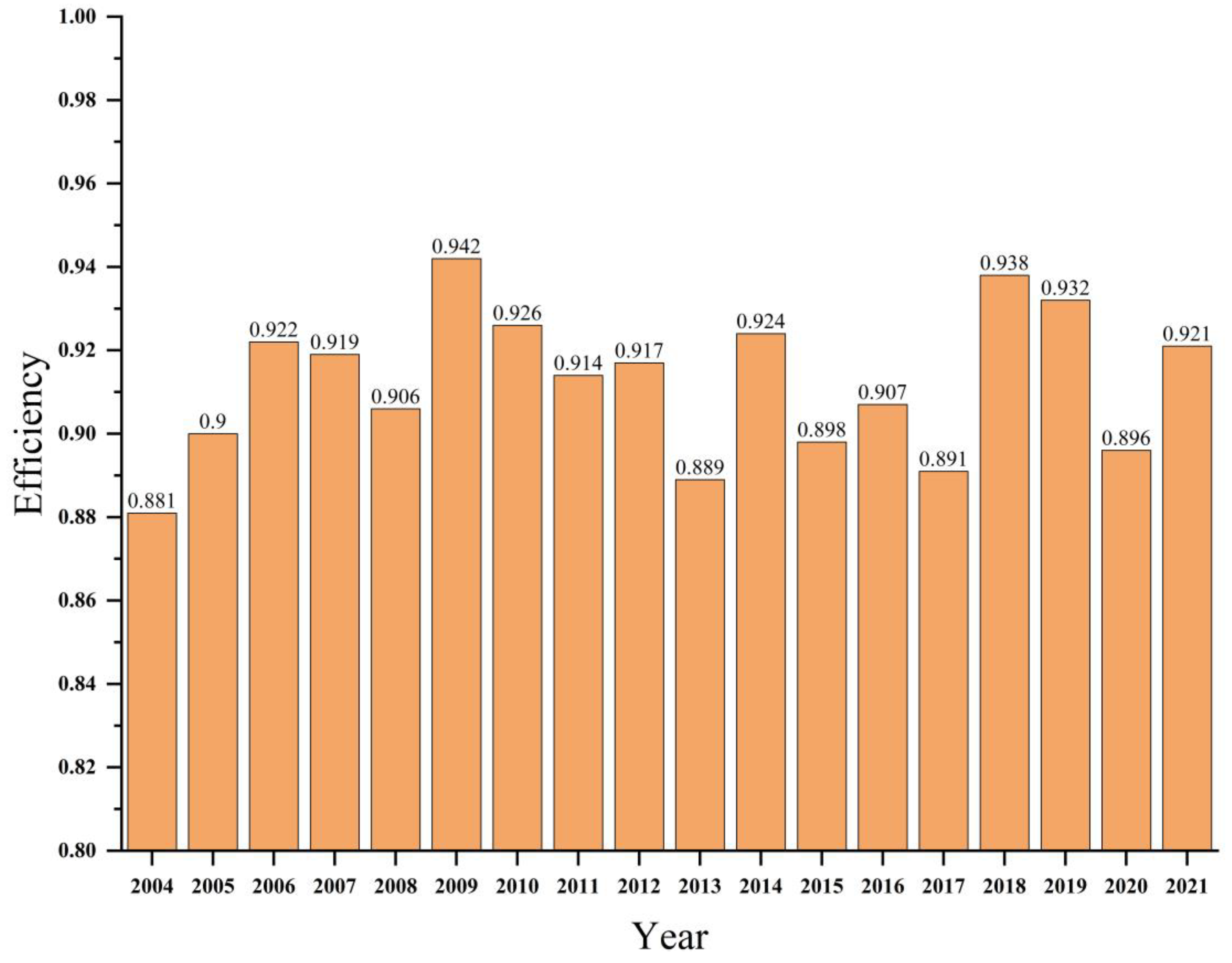

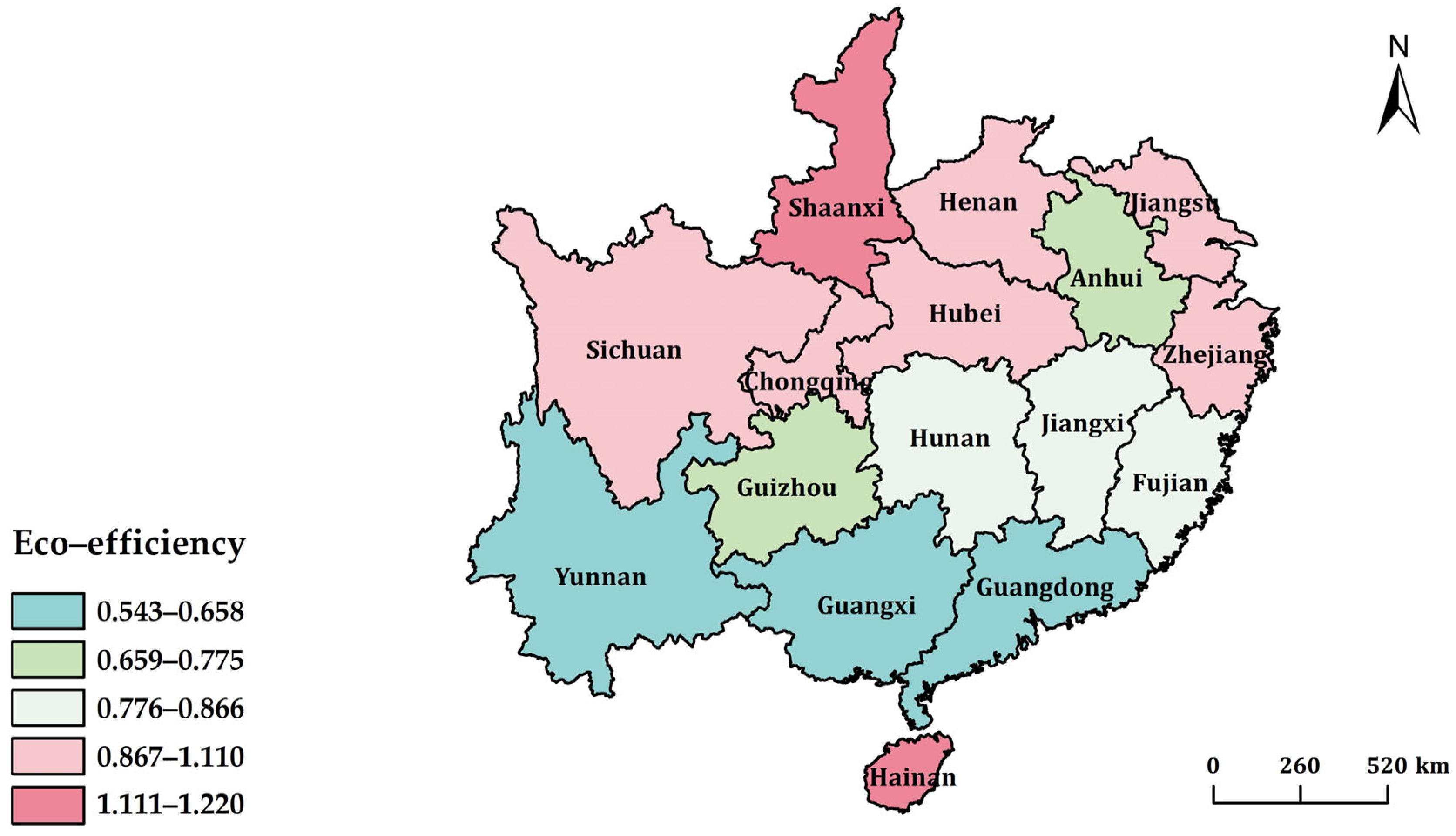
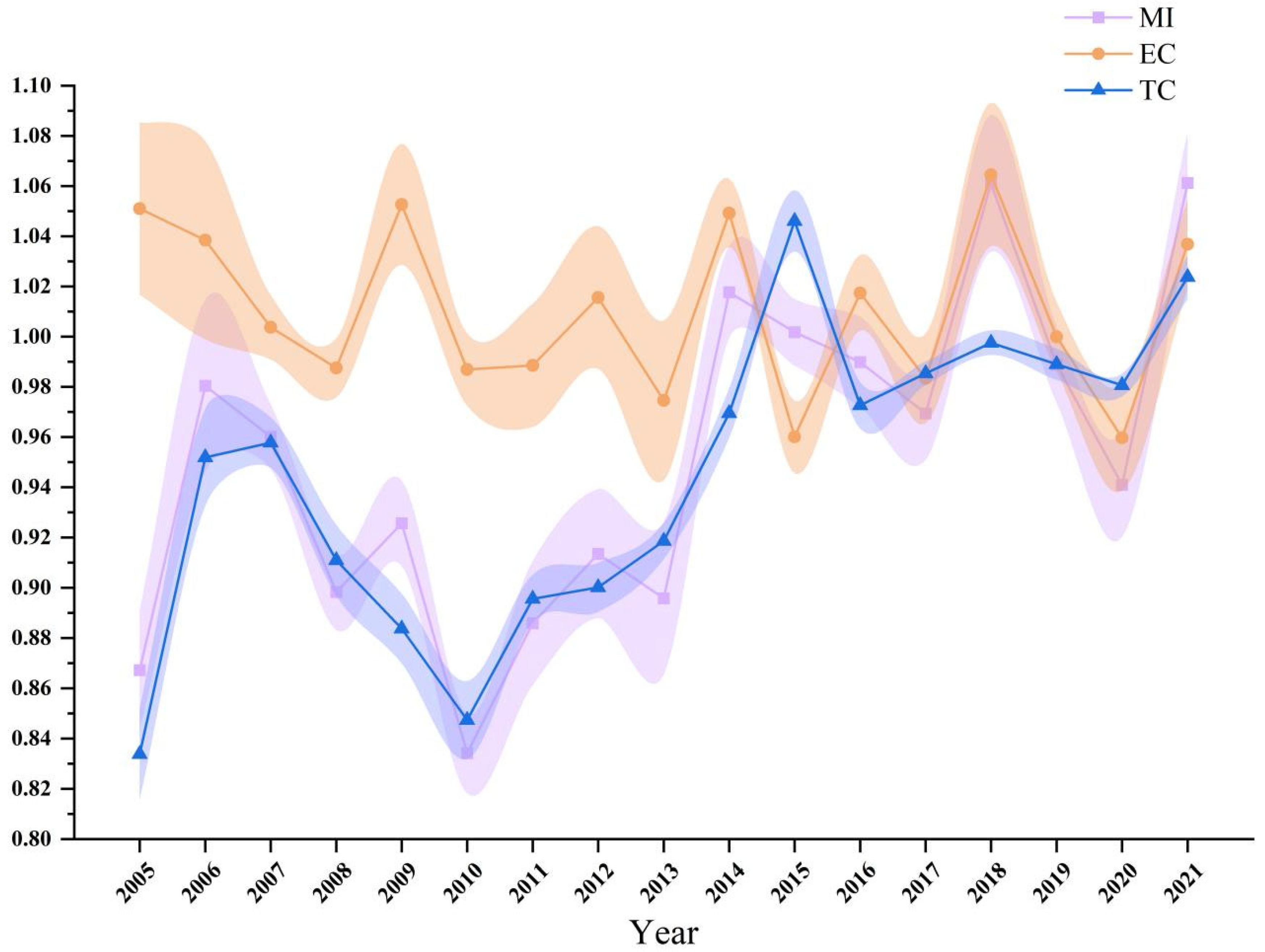

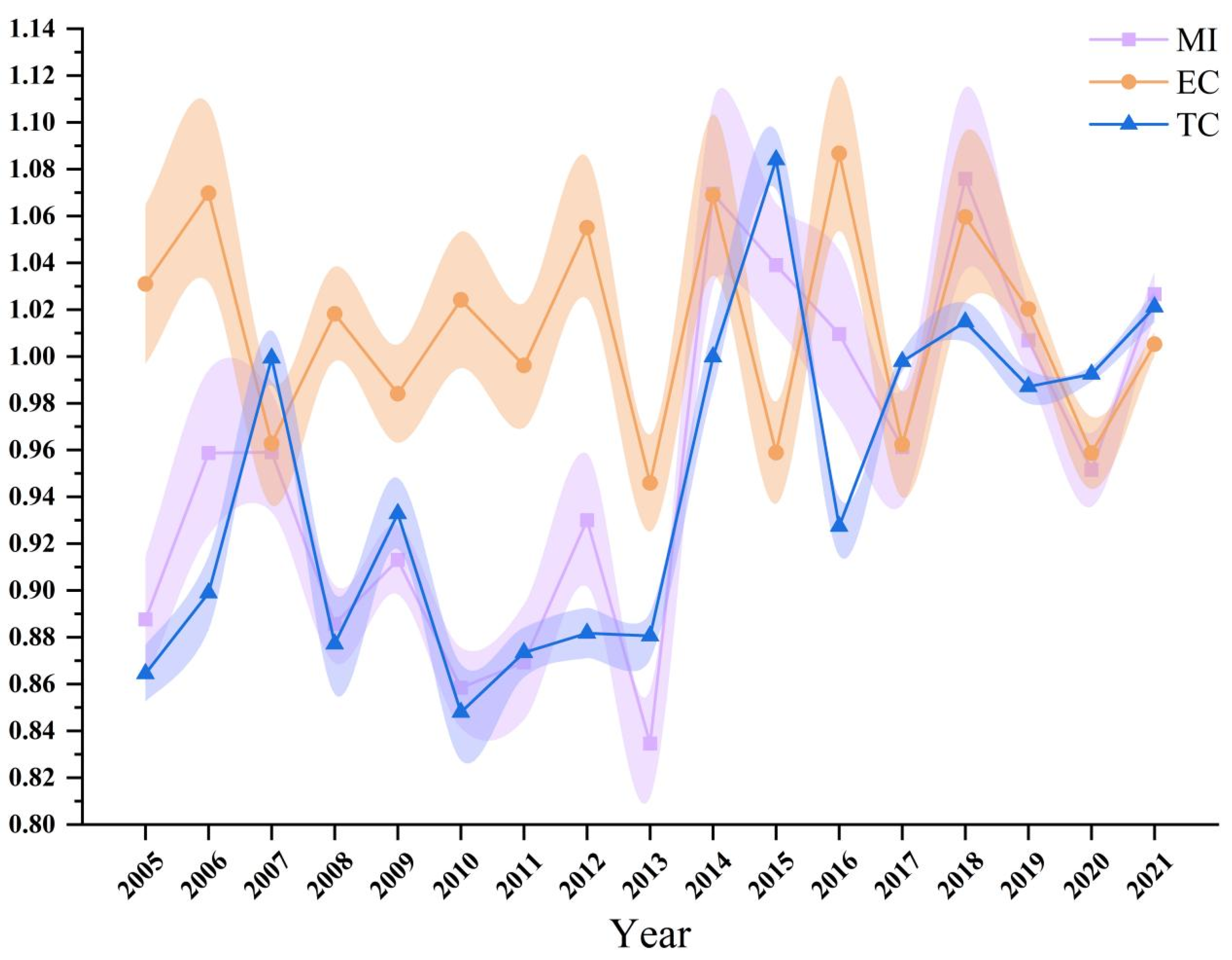
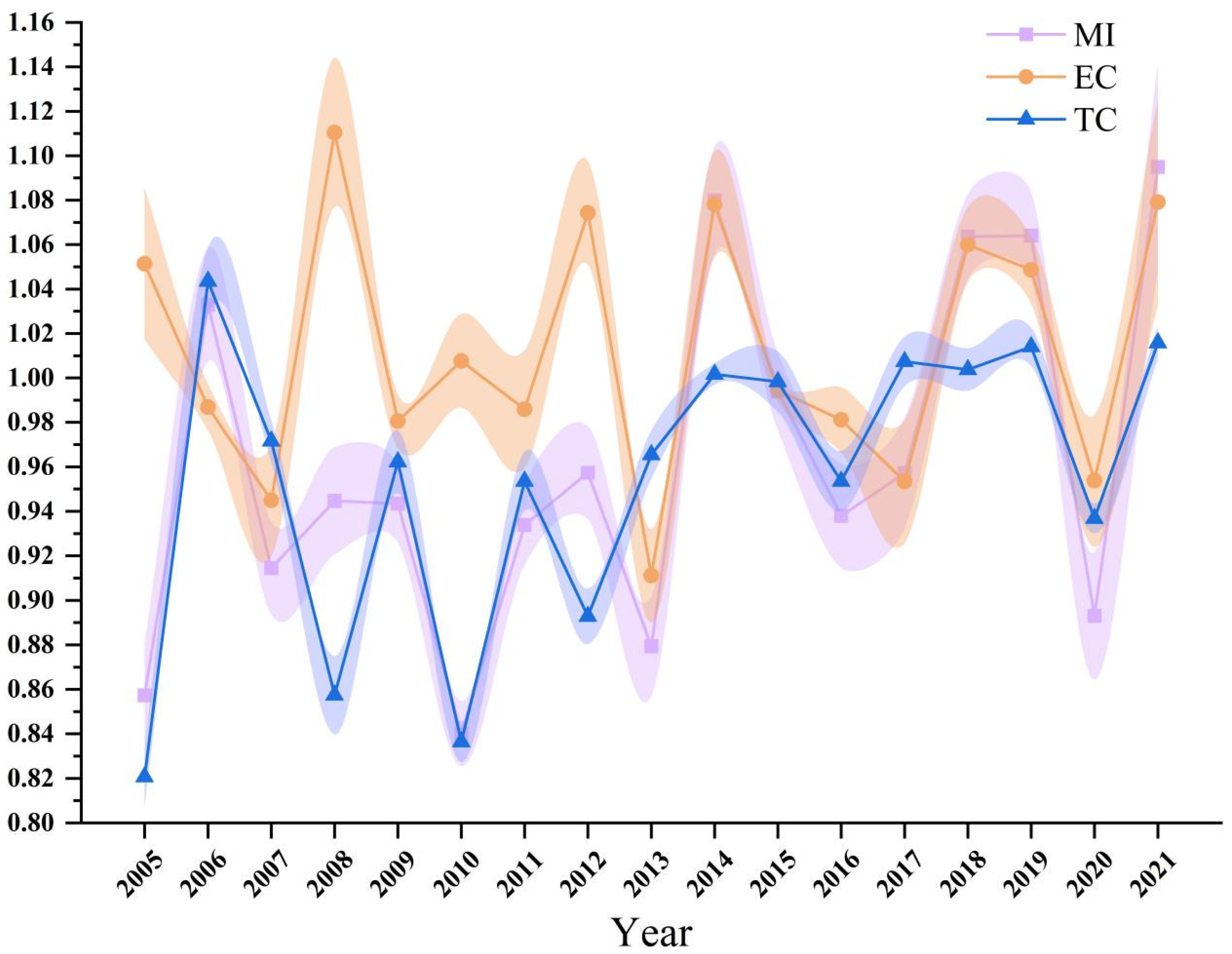

| Abbreviation | Full Name |
|---|---|
| DEA | Data Envelopment Analysis |
| SBM | Slacks-Based Measure |
| DMU | Decision Making Units |
| MI | Malmquist Index |
| EC | Technical Efficiency Change |
| TC | Technical Change |
| TPM | Total Power of Agricultural Machinery |
| First-Level Indicators | Second-Level Indicators | Composition of Indicators (Per Mu) | Symbol | Unit |
|---|---|---|---|---|
| Input Indicators | Direct cost | Seed + Fertilizer + Farmyard Manure + Pesticides + Plastic Film Cost + Machinery Operation Cost + Water Use Fee + Technical Service Fee + Fuel Power Fee + Other Direct Costs | DC | yuan/mu |
| Total power of agricultural machinery | Total Agricultural Machinery Power of Each Province | TPM | 10,000 kilowatts | |
| Labor cost | Opportunity Cost of Family Labor + Hired Labor Cost | LC | yuan/mu | |
| Land cost | Rental Cost of Transferred Land + Opportunity Cost of Own Land | LDC | yuan/mu | |
| Comprehensive Output Indicators | Yield of Indica Rice | Yield of Early Indica Rice/Medium Indica Rice/Late Indica Rice | YI | kg |
| Environmental Pollution | Carbon Emissions During Indica Rice Production | EP | kg/mu |
| Classification | Variables | Unit | Mean | Standard Deviation | Minimum | Maximum |
|---|---|---|---|---|---|---|
| Overall Indica Rice | DC | yuan/mu | 368.43 | 115.64 | 139.65 | 664.12 |
| LDC | yuan/mu | 133.29 | 67.63 | 22.96 | 336.98 | |
| LC | yuan/mu | 434.57 | 260.77 | 110.49 | 1188.88 | |
| TPM | 10,000 kilowatts | 3243.87 | 2327.65 | 243.90 | 11,710.10 | |
| YI | kg | 463.22 | 62.85 | 273.30 | 659.73 | |
| EP | kg/mu | 19.68 | 2.88 | 13.45 | 31.91 | |
| Early Indica Rice | DC | yuan/mu | 383.57 | 117.70 | 128.71 | 620.02 |
| LDC | yuan/mu | 132.30 | 63.39 | 23.11 | 300.49 | |
| LC | yuan/mu | 342.14 | 161.56 | 104.86 | 788.41 | |
| TPM | 10,000 kilowatts | 2922.73 | 1759.80 | 243.90 | 6924.30 | |
| YI | kg | 409.20 | 27.30 | 326.50 | 482.51 | |
| EP | kg/mu | 20.57 | 2.78 | 11.80 | 26.45 | |
| Medium Indica Rice | DC | yuan/mu | 348.98 | 104.72 | 142.39 | 564.66 |
| LDC | yuan/mu | 136.58 | 72.36 | 26.08 | 336.98 | |
| LC | yuan/mu | 478.17 | 284.46 | 110.49 | 1188.88 | |
| TPM | 10,000 kilowatts | 3746.53 | 2568.01 | 728.30 | 11,710.10 | |
| YI | kg | 511.05 | 46.06 | 361.76 | 659.73 | |
| EP | kg/mu | 19.12 | 2.85 | 13.45 | 31.91 | |
| Late Indica Rice | DC | yuan/mu | 410.90 | 128.22 | 150.59 | 733.52 |
| LDC | yuan/mu | 135.63 | 63.19 | 22.80 | 326.20 | |
| LC | yuan/mu | 346.09 | 157.53 | 120.33 | 765.60 | |
| TPM | 10,000 kilowatts | 2922.73 | 1759.80 | 243.90 | 6924.30 | |
| YI | kg | 421.78 | 68.64 | 220.10 | 560.23 | |
| EP | kg/mu | 19.76 | 2.66 | 14.79 | 26.00 |
Disclaimer/Publisher’s Note: The statements, opinions and data contained in all publications are solely those of the individual author(s) and contributor(s) and not of MDPI and/or the editor(s). MDPI and/or the editor(s) disclaim responsibility for any injury to people or property resulting from any ideas, methods, instructions or products referred to in the content. |
© 2023 by the authors. Licensee MDPI, Basel, Switzerland. This article is an open access article distributed under the terms and conditions of the Creative Commons Attribution (CC BY) license (https://creativecommons.org/licenses/by/4.0/).
Share and Cite
Lu, Y.; Sun, Z.; Yao, G.; Xu, J. Assessing Eco-Efficiency with Emphasis on Carbon Emissions from Fertilizers and Plastic Film Inputs. Agronomy 2023, 13, 2720. https://doi.org/10.3390/agronomy13112720
Lu Y, Sun Z, Yao G, Xu J. Assessing Eco-Efficiency with Emphasis on Carbon Emissions from Fertilizers and Plastic Film Inputs. Agronomy. 2023; 13(11):2720. https://doi.org/10.3390/agronomy13112720
Chicago/Turabian StyleLu, Yixuan, Zhixian Sun, Guanxin Yao, and Jing Xu. 2023. "Assessing Eco-Efficiency with Emphasis on Carbon Emissions from Fertilizers and Plastic Film Inputs" Agronomy 13, no. 11: 2720. https://doi.org/10.3390/agronomy13112720





